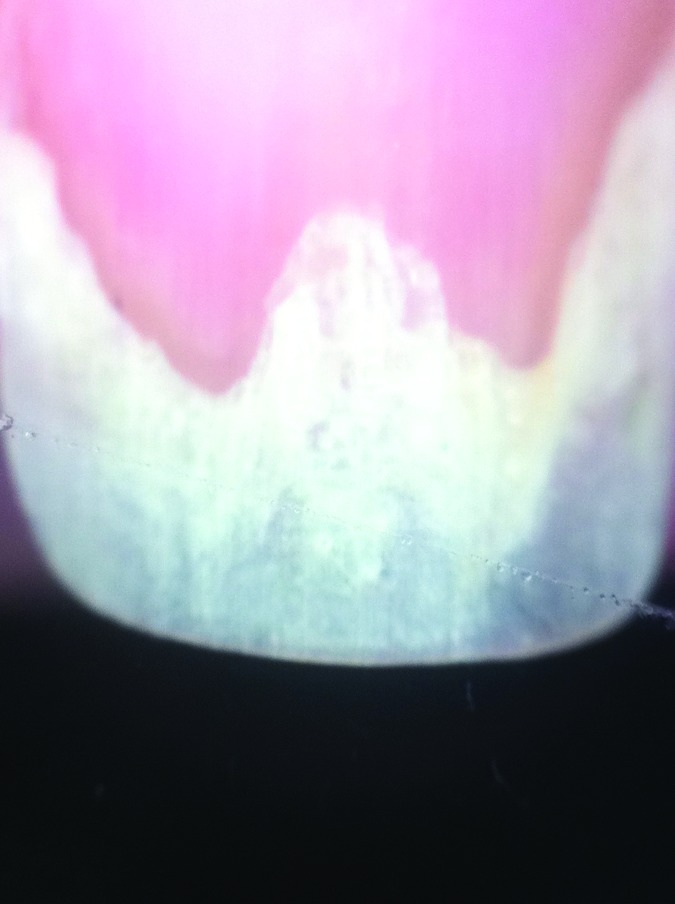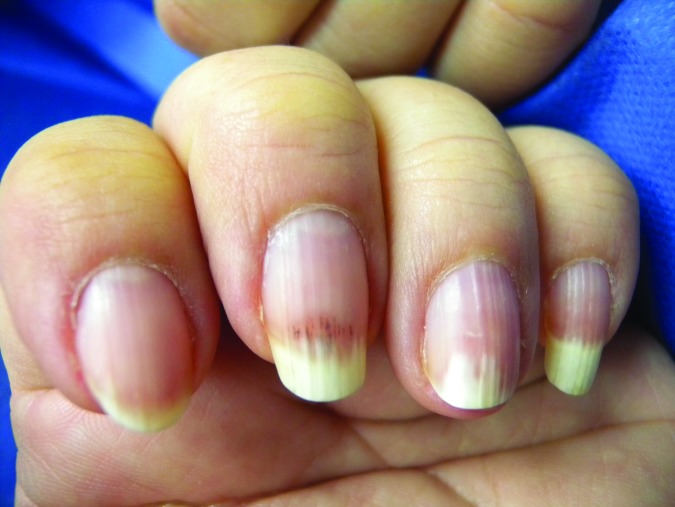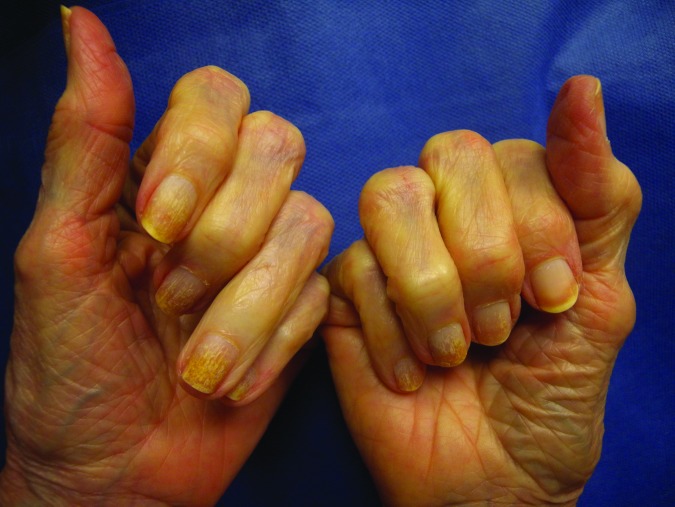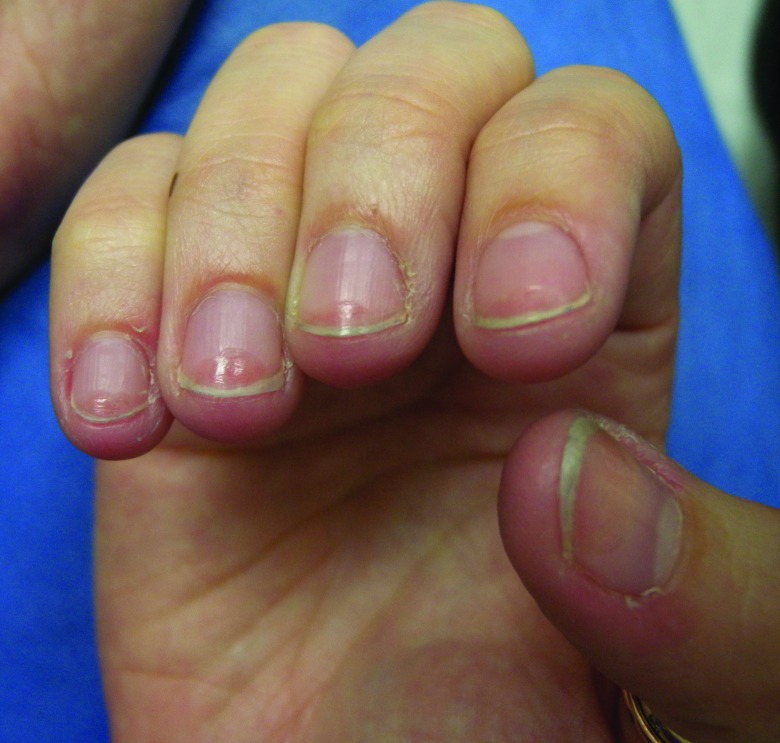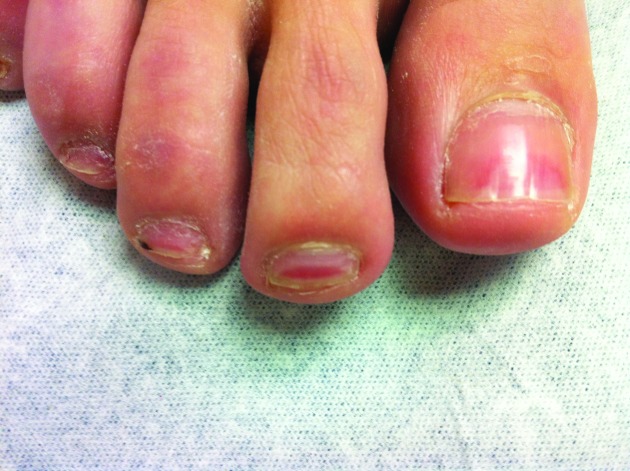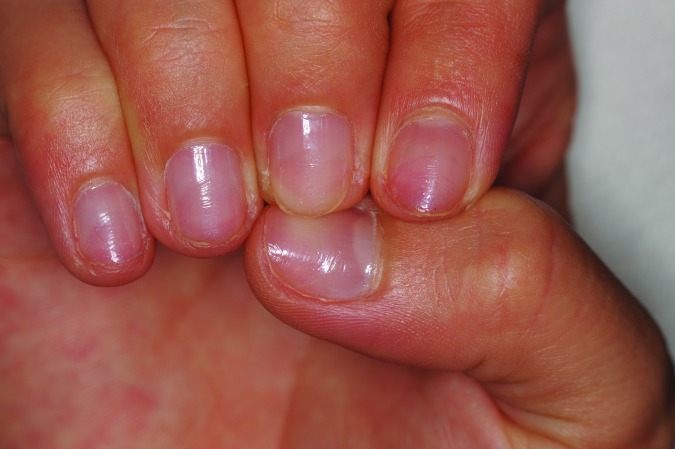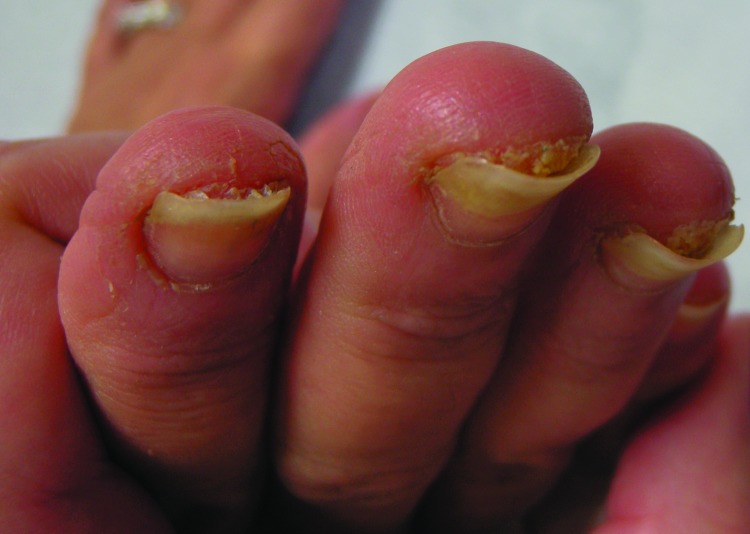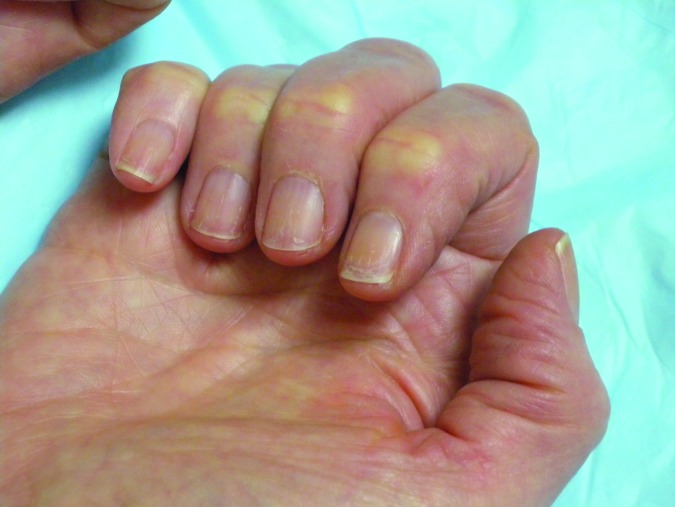Abstract
The nail carries a significant cosmetic impact and plays an integral role in the multi-billion dollar salon industry. This review focuses on nail disorders that are induced by nail cosmetics via procedures, equipment, or materials that are intended to beautify or adorn the nail. The authors give specific attention to clinical presentations that are common, novel, and underreported, but may be misdiagnosed easily by the competent dermatologist. They also provide an update on the controversies surrounding contemporary nail cosmetic procedures, such as acrylic and gel manicures.
In addition to providing a protective barrier, the nail plays an essential role in patient appearance. Along with the face, neck, and hands, the nails are one of the few areas of the body to receive consistent exposure. Thus, nail appearance, which historically has served as proxy for social status, carries a significant cosmetic impact. In addition, nails may have a large psychological impact, with the appearance of groomed and clean nails important for employability, the conduct of business, and social functions.
In 2014, $8.54 billion were spent on nail salon services in the United States.1 Consumers of nail-related products are largely women who seek treatment at nail salons, medi-spas, or in their homes instead of through a medical facility, where rigorous oversight standards are in place. However, nail cosmetics may be an emerging trend for men, many of whom are powerful professionals (e.g., attorneys, businessmen, and creative professionals). These individuals may not have previously promoted their use of manicures, but may now feel less stigmatized given the renaissance of cosmetic dermatology for men.
This review focuses on nail disorders that are induced by nail cosmetics via procedures, equipment, or materials that are intended to beautify or adorn the nail. The authors pay particular attention to clinical presentations that are common and underreported, but may be misdiagnosed easily by the competent dermatologist. They also provide an update on contemporary nail cosmetic procedures.
COMMON DISORDERS FROM NAIL MANICURE MATERIALS AND PROCESS
The process of salon-administered nail manicure utilizes numerous procedures and materials, many of which have documented hazards. Known risks of traditional manicures include procedure-related infections (bacterial, fungal, mycobacterial, and viral, including human papilloma virus and herpes simplex virus).2 Inadequately sterilized instruments, such as clippers, blades, abrasive files, electric drills, and footbaths, may harbor and abet the growth of micro-organisms. Micro and macro-traumas may be induced through the cleaning, filing, and trimming of cuticles, thus allowing the infiltration of micro-organisms. Materials, such as nail polish and nail enhancers, contain certain chemicals that can serve as contact sensitizers when accidentally applied to periungual skin. Chemicals, including acrylates, formaldehyde, and toluene sulphonamide-formaldehyde resin, may lead to contact dermatitis and chronic paronychia.3-6 Primers and polish removers, which are largely solvents, can dry nails and contribute to brittleness. The following clinical examples are less frequently reported, but not uncommon disorders related to nail cosmetics.
Discoloration of the nail plate. One of the most common sequelae of nail polish, discoloration of the nail plate, is due to harmless keratin staining from nail polish. Discoloration theoretically may appear as any color, but is largely reported to be red or yellow. This phenomenon is very common if pigmented polish is left on for a week or more, and resolves in approximately two weeks without treatment after polish has been removed.7 Although previous reports have indicated that nail discoloration can be avoided with application of a base coat, the authors’ experience indicates that a base coat does not always provide adequate protection.
Traumatic onycholysis. Traumatic onycholysis is another common phenomenon that stems from the traumatic separation of the nail plate from the nail bed due to disruption of the onychodermal band. Patients have been known to insert a variety of thin, sharp objects into the potential space between the distal plate and bed in efforts to clean under the nails. The diagnosis of traumatic onycholysis is suggested when patients present with “roller coaster nails” (Figure 1) in which the proximal border of the onycholytic nail plate assumes a characteristic oscillating pattern. Traumatic onycholysis is often associated with chronic paronychia. Such infections occur as manicure removal of the cuticle breaks an essential barrier to micro-organism infiltration of the nail. Dermoscopy can be useful in visualizing pinpoint hemorrhagic macules on traumatized areas (Figure 2). With this condition, patients often deny manipulating the nail subunit, thus making the clinical history, and sometimes persistent questioning about cleaning and hygiene habits, of great importance. In patients wearing acrylic nails, traumatic onycholysis is very common. These patients usually wear very long nails, and adhesion of the acrylic nail to the nail plate is stronger than adhesion of the nail plate to the nail bed.
Figure 1.
Traumatic onycholysis, roller coaster variant
Figure 2.
Traumatic onycholysis with hemorrhage
Keratin degranulation. The process of nail polish binding to and subsequently being removed from the nail plate may result in keratin degranulation. The clinical features of this finding are white striations, macules, and patches on the nail plate. Dermoscopy shows that the white areas correspond to areas of nail plate exfoliation. Keratin degranulation is a type of pseudoleukonychia, and a phenomenon seen secondary to nail polish interaction with keratin in the nail plate (Figure 3). At this time it is unclear if different types of nail polish more frequently cause degranulation. The authors’ clinical experience indicates that longer lasting polishes may cause greater trauma to the nail plate. Although keratin degranulation may be confused with white superficial onychomycosis, this type of onychomycosis does not occur on the fingernails.
Figure 3.
Keratin degranulation and discoloration from nail polish
Mycobacterial infections. Pedicure footbaths, while incredibly popular, may trap dirt, lint, and skin debris. Without proper sterilization or regular filter changes, such systems support the growth of mycobacterium. In fact, pedicure footbath-associated mycobacterial infections have been reported on several occasions throughout the United States since 2002, when a group from California reported a case series of mycobacterium fortuitum furunculosis that was traced back to a single salon.8-10 Clinical manifestations include erythematous macules and papules of the distal legs that appear two weeks or more after pedicure. Lesions may progress over weeks to abscesses that heal with dyspigmentation and scarring.2
Specific risks with acrylic and gel manicures. What is the difference between acrylic and gel manicures? Acrylic nails are a type of artificial nail enhancement created from a mixture of both liquid and powder acrylates. They do not require photocuring.11 Gels are a type of acrylic-based nail polish. They are composed of a mixture of acrylate monomers that require ultraviolet (UV) light for polymerization and hardening.11,12 Gel manicure systems are a variant of acrylic nail gel and contain the traditional nail lacquer plus a base coat. The base contains photo-initiators and UV-curable acrylate oligomers instead of solvent/resin bases. During the curing process, solvents evaporate, and small channels form in the layer of nail polish. These channels are connected by acetone-dissolvable polymers.
Gels have gained significant popularity over the past five years due to their luster, shine, and resistance to chipping, scratching, and denting. Gel manicures have existed since the early 2000s, but did not achieve great exposure until a 2010 marketing campaign from CND® (Creative Nail Design, Inc.) for Shellac® polish. OPI, Inc., followed suit in 2011 with their release of GelColor. Although both products boast lengthy ingredient lists (Tables 1 and 2), with the exception of acrylate monomers (discussed below), there have been no reports of adverse reactions to their ingredients. However there now exist many new products in the marketplace, including non-professional brands for which side effects may yet emerge.
TABLE 1.
Shellac® 14+ day nail color
| BASE COAT | COLOR COAT | TOP COAT |
|---|---|---|
| Proprietary formula | Proprietary formula | Cellulose acetate butyrate |
| Acetone | Butyl acetate | Aliphatic uretane methacrylate oligomer |
| Ethanol | 2 women | Di-hematrimethylhexyl dicarbamate |
| Butyl acetate | 10 women, 1 man | Tetrahydrofurfuryl methacrylate Polypropylene glycol monomethacrylate Butyl acetate Ethyl acetate Ethyl trimethylbenzoyl phenylphosphinate CL 60730 (ext. violet 2) |
Material Safety Data Sheet CND Shellac UV Base Coat, UV Color Coat, UV Top Coat. www.cnd.com. (Mar 2010).
TABLE 2.
OPI GelColor
| BASE COAT | COLOR COAT | TOP COAT |
|---|---|---|
| Ethyl acetate | Di-Hema Trimethylhexyl dicarbamate | Di-Hema Trimethylhexyl dicarbamate |
| Alcohol denat. (SD alcohol 40-B) | Hema | Hema |
| Di-Hema Trimethylhexyl dicarbamate | Hydroxypropyl Methacrylate | Hydroxypropyl Methacrylate |
| Butyl acetate Heptane Nitrocellulose Tosylamide/Epoxy Resin Hema Hydroxypropyl Methacrylate Isobornyl methacrylate Isopropyl alcohol Trimethyl pentanyl diisobutyrate Polyvinyl butyral Camphor Trimethylbenzoyl diphenylphosphine oxide Hydroxycyclohexyl phenyl ketone Benzophenone-1 Dimethicone CI 60725 (Violet 2) CI 17200 (Red 33) | Trimethylbenzoyl diphenylphosphine oxide Hydroxycyclohexyl phenyl ketone Polysilicone-13 May contain (colorants, shimmers, & color blend components)** | Trimethylbenzoyl diphenylphosphine oxide Hydroxycyclohexyl phenyl ketone Polysilicone-13 CI 60725 (Violet 2) |
Material Safety Data Sheet OPI GelColor Base Gel, All Shades, Top Sealer www.opi.com. (June 2011).
Mica, Calcium aluminum borosilicate, calcium sodium borosilicate, tin oxide, silica, Red 6 (CI 15850), Red 7 (CI 15850), CI 17200 (Red 33), CI 19140 (Yellow 5), CI 42090 (Blue 1), CI 45410 (Red 27), CI 60725 (Violet 2), CI 73360 (Red 30), CI 75470 (Carmine), CI 77007 (Ultramarines), CI 77120 (Barium Sulfate), CI 77163 (Bismuth oxychloride), CI 77491 (Iron oxides), CI 77492 (Iron oxides), CI 77499 (Iron oxides), CI 75510 (Ferric fer-rocyanide), CI 77742 (Manganese violet), CI 77891 (Titanium dioxide), Synthetic wax, Isopropyl titanium triisostearate, Hydrogenated poly-isobutene, Palmitic acid, Phenoxyethanol, Benzoic acid, PEG-12 dime-thicone, synthetic fluorphlogopite, butyl acetate, ethyl acetate, nitrocellulose, isopropyl alcohol, adipic acid/neopentyl glycol/trimellitic anhydride copolymer, stearalkonium hectorite, diacetone alcohol, benzophenone-1, citric acid, talc (containing no asbestos fibers)
The application process of gel-based manicures includes serial applications to the nail plate with a base primer, followed by a color coat and a top coat. The nails must then be cured by UVA rays or photocuring after each coat. Nail salons predominantly use fluorescent UV lamps although some use light-emitting diode (LED) lights.13 LED lights, though more costly, require a shorter exposure time to UV radiation. Removal of gel manicures requires soaking the nail plate with 100% acetone for 10 to 15 minutes, followed by manual debridement of remaining polish if necessary.
Contact dermatitis. Although the risk of allergic contact dermatitis to nail cosmetics is well-established, there have been an increased number of cases of acrylate monomer-associated contact dermatitis with the increased utilization of photobonded acrylic gel nails.11,14 Cases typically include periungual eczematous dermatitis, but there exist reports of eczematous lesions in more proximal locations of the hand and face, purportedly via airborne transit of nail dust.15,16 In one case series, three of four patients, two of whom were manicurists who also received gel manicures and two of whom were frequent customers of gel nail manicures, had positive patch test reactions to 2-HEMA (2-hydroxyethyl methacrylate) and 2-HPMA (2-hydroxylpropyl methacrylate). One of the cases also had an eyelid dermatitis and a positive patch test to triethylene glycol diacrylate (TREGDA). In all cases, the dermatitis resolved after removal of acrylic gel nails or discontinuing work with gel manicures.17 Less frequently, paronychia, nail dystrophy, and onycholysis have been reported.14
Peripheral neuropathy. Peripheral neuropathy, a rare complication of acrylic cosmetic nails, has been reported in a few cases of patients with positive patch testing to methacrylates.18,19 Although the mechanism of toxicity is unknown, it may be associated with local neuropathy induced by methylmethacrylate. Similar findings have been demonstrated in a small murine model in which rat tail skin was exposed to controlled amounts of methylmethacrylate. Findings included keratolysis without ulceration on the exposed skin and abnormal motor responses to stimulation of rat tail motor nerves.20
Worn down nails (overfiled nails). Worn down, or overfiled, nails represent the direct result of patient or nail salon operator-induced mechanical trauma. This phenomenon is typically seen in patients wearing acrylic nails, as complete removal of the nails often requires mechanical abrasion. Nails are filed tangentially to eliminate resin residues, reduce superficial irregularities, and improve texture and appearance. Clinically the nails show distal thinning with a triangular or half-moon morphology extending distally from the mid-plate, and forming a mirror image to the lunula (Figures 4A and 4B). The overfiled section of nail often appears red in color as with repeated filing, and the plate is thinned, allowing visibility of the nail bed through the plate.21 Linear striations, representing the back-and-forth mechanical filing of nails, can sometimes be viewed on clinical exam, and are often easily visible using dermoscopy (Figure 5). Other dermoscopic features may include dilated capillaries and pinpoint hemorrhages.
Figure 4A.
Overfiled nails
Figure 4B.
Overfiled nails
Figure 5.
Overfiled nails with striations
Pseudo-psoriatic nails. Pseudo-psoriatic nails describe a clinical pattern that has been reported in patients wearing acrylic nails. Clinical features, including onycholysis and severe subungual hyperkeratosis, are often quite similar to those of psoriatic nails (Figure 6). In fact, cases have been misdiagnosed and mistreated with topical and intralesional corticosteroids or even immunosuppressants if there is coincident joint pain. Although this clinical pattern theoretically may be triggered by traumatic removal of firmly attached acrylic nails via Koebnerization, the authors have seen patients with pseudo-psoriatic nails that developed before the removal of acrylic nails. These patients have had positive patch testing to methylmethacrylate, suggesting that acrylate sensitization can cause this clinical phenotype.
Figure 6.
Pseudo-psoriatic nails
Other side effects of gel manicures. Although touted as easy to remove, gel polish is often firmly adhered. The removal process may be associated with generalized nail thinning, weakness, brittleness, pseudoleukonychia, and onychoschizia lamellina (Figure 7).22 Though there has been some concern that acrylic manicures block oxygen transfer through the nails and may predispose to inadequate oxygenation of the nail bed, there is no evidence in the published medical literature to support this claim.
Figure 7.
Thinning and nnychoschizia after gel polish manicure
Ultraviolet light: Cutaneous malignancy and ocular toxicity. UV light, which is used to cure gel nails, received scrutiny after two healthy, middle-aged women with no personal or family history of skin cancer developed squamous cell carcinomas (SCC) on their dorsal hands, and both reported previous exposure to UV radiation for cosmetic nail treatment.23 After an initial frenzy, which included some dermatologists recommending avoiding gel manicures, several groups investigated the risks of exposure to UV light from photobonded manicures. Diffey 24 generated a mathematical model combining age and UV exposure and compared risk of developing SCCs from typical sun exposure with the risk of inducing SCCs from UVA nail lamp exposure. He concluded that the risk was very low and that tens or hundreds of thousands of women would need to use a UVA nail lamp regularly in order to develop a single SCC on the dorsum of the hands as a direct consequence. He also demonstrated that the risk could be reduced almost to zero by wearing fingerless gloves when nails are being treated.24 Markova and Weinstock 13 compared the risks of UV nail lamp irradiance with narrowband UVB (nbUVB), an established very low-risk procedure. They calculated that one would require more than 250 years of weekly UV nail treatments to incur the same risk as a single course of nbUVB (15-30 treatments for 5-10 weeks). This is effectively insignificant UV exposure with no increase in risk of SCC.13 Moreover, a photobiological safety analysis of UV nail lamps demonstrated that the amount of exposure experienced by consumers of UV photocured manicures was trivial.25
The question of the role of salon lamp light on the eye is less clear. Cumulative exposure to UV light is a known cause of cataracts and may play a role in the pathogenesis of macular degeneration. Although the dose of UV from salon lamps is small, the amount of UV varies from machine to machine and depends on positioning under the lamp.26For nail manicures, the hands are placed in a UV light unit where there is light scatter from the box to the eyes. However, the amount of this scatter is unknown. Because of this uncertainty and concerns for ocular toxicity, some dermatologists recommend that frequent utilizers of photobonded manicures use UV-filtered glasses to protect the eyes. Additionally, some dermatologists recommend wearing gloves to protect the hands from photoaging.27 While these recommendations will certainly do no harm and may help offset any minimal exposures to UV light, it is unclear whether exposure to nail salon UV light plays any meaningful role in ocular toxicity.
CONCLUSION
Given the widespread use of nail cosmetics, dermatologists must understand the techniques and materials used in the nail industry to properly diagnose and prevent common cosmetically induced nail disorders. These conditions are easily identified, and unnecessary treatments can be avoided once the clinical patterns have been learned. Moreover, since many dermatologists embrace the use of cosmetology as a supportive treatment and a bridge between a patient’s time of presentation for a nail disorder and the 3- to 6-month lag for treatment efficacy, it is important to both inform patients of the proper use of nail cosmetics and understand novel nail cosmetic procedures. It is often helpful to provide patients with a simple handout or list of rules to follow when preparing for a manicure or pedicure. Particular attention should be paid to the licensing of the salon and manicurist/pedicurist, the cleanliness of footbaths and instruments, the overall hygiene of the salon, and the time spent using UV lights. Adapted from Chang et al,2 the authors’ recommend that patients do the following:
Avoid pedicure footbaths unless they have a regularly cleaned filtration system that utilizes circulating bleach.
Bring their own instruments, or ensure that instruments have been sterilized via autoclave.
Avoid leg shaving/waxing for more than 24 hours prior to pedicures.
Do not let technicians trim or manipulate cuticles.
Do not let technicians clean under the nail with sharp instruments.
Limit the frequency and time of nail salon UV exposure. Ask salon operators what type of lights they use, and choose LED lights when possible. Consider UV-protected eyeglasses and fingerless gloves if obtaining frequent treatments.
At this time, although it appears that the new generation of acrylic gel manicures poses a negligible risk of skin cancer, regular use can lead to contact dermatitis as well as brittle and thin nails. The risks of nail salon lamp UV lights on the eye requires more investigation. However, with proper precautions, patients can continue to use nail cosmetics safely.
Footnotes
DISCLOSURE:Dr. Rieder reports no relevant conflicts of interest. Dr. Tosti is an Advisory Board member for Meiji, Valeant, Viamet, PharmaDerm/Sandoz, and Polichem, and serves on the Speakers Bureau for PharmaDerm/Sandoz.
REFERENCES
- 1.Nails Magazine. Vol Torrance, CA: Bobit Business Media; 2015. Nails Big Book: Everything You Need To Know About the Nail Industry; pp. 56–78. [Google Scholar]
- 2.Chang R, Hare A, Rich P. Treating cosmetically induced nail problems. Dermatol Ther. 2007;20:54–59. doi: 10.1111/j.1529-8019.2007.00111.x. [DOI] [PubMed] [Google Scholar]
- 3.Kiec-Seierczynaka M. Occupational allergic contact dermatitis due to acrylates in Lodz. Contact Dermatitis. 1996;34:419–422. doi: 10.1111/j.1600-0536.1996.tb02245.x. [DOI] [PubMed] [Google Scholar]
- 4.Hemmer W, Focke M, Wantke F, et al. Allergic contact dermatitis to artificial fingernails prepared from UV light-cured acrylates. J Am Acad Dermatol. 1996;35:377–380. doi: 10.1016/s0190-9622(96)90600-3. [DOI] [PubMed] [Google Scholar]
- 5.Fuchs T, Gutgesell C. Is contact allergy to toluene sulphonamide-formaldehyde resin common? Br J Dermatol. 1996;135:1003–1017. doi: 10.1046/j.1365-2133.1996.d01-1120.x. [DOI] [PubMed] [Google Scholar]
- 6.Hausen B, Milbrodt M, Koenig W. The allergens of nail polish: allergenic constituents of common nail polish and toluene sulfonamide-formaldehyde resin (TSFR) Contact Dermatitis. 1995;33:157–164. doi: 10.1111/j.1600-0536.1995.tb00537.x. [DOI] [PubMed] [Google Scholar]
- 7.Iorizzo M, Piraccini B, Tosti A. Nail cosmetics in nail disorders. J Cosmetic Dermatol. 2007;6:53–58. doi: 10.1111/j.1473-2165.2007.00290.x. [DOI] [PubMed] [Google Scholar]
- 8.Winthrop K, Abrams M, Yakrus M, et al. An outbreak of mycobacterial furunculosis associated with footbaths at a nail salon. NEngl J Med. 2002;346(18):1366–1371. doi: 10.1056/NEJMoa012643. [DOI] [PubMed] [Google Scholar]
- 9.Stout J, Gadkowski L, Rath S, et al. Pedicure-associated rapidly growing mycobacterial infection: an endemic disease. Clin Infect Dis. 2011;53(8):787–792. doi: 10.1093/cid/cir539. [DOI] [PubMed] [Google Scholar]
- 10.Wertman R, Miller M, Groben P, et al. Mycobacterium bolletti/Mycobacterium massiliense furunculosis associated with pedicure footbaths: a report of 3 cases. Arch Dermatol. 2011;147(4):454–458. doi: 10.1001/archdermatol.2011.58. [DOI] [PubMed] [Google Scholar]
- 11.Le Q, Cahill J, Palmer-Le A, Nixon R. The rising trend in allergic contact dermatitis to acrylic nail products. Australas J Dermatol. 2015;56(3):221–223. doi: 10.1111/ajd.12311. [DOI] [PubMed] [Google Scholar]
- 12. Material Safety Data Sheet for Gelique™ Base & Top Gel and Gel Polish. Sydney, Australia: Hawley International; February 2014. [Google Scholar]
- 13.Markova A, Weinstock M. Risk of skin cancer associated with the use of UV nail lamp. J Invest Dermatol. 2013;133(4):1097–1099. doi: 10.1038/jid.2012.440. [DOI] [PubMed] [Google Scholar]
- 14.Lazarov A. Sensitization to acrylates is a common adverse reaction to artificial fingernails. J Eur Acad Dermatol Venereol. 2007;21:169–174. doi: 10.1111/j.1468-3083.2006.01883.x. [DOI] [PubMed] [Google Scholar]
- 15.Vazquez-Osorio I, Espasandin-Ariasa M, Garcia-Gavin J, Fernandez-Redondo V. Allergic contact dermatitis due to acrylates in acrylic gel nails: a report of 3 cases. Actas Dermo-Sifiliograficas. 2014;105(4):430–432. doi: 10.1016/j.adengl.2013.04.027. [DOI] [PubMed] [Google Scholar]
- 16.Maio P, Carvalho R, Amaro C, et al. Allergic contact dermatitis from sculptured acrylic nails: special presentation with an airborne pattern. Dermatol Reports. 2012;4(1):e6. doi: 10.4081/dr.2012.e6. [DOI] [PMC free article] [PubMed] [Google Scholar]
- 17.Cravo M, Cardoso J, GonÇalo M, Figueiredo A. Allergic contact dermatitis from photobonded acrylic gel nails: a review of four cases. Contact Dermatitis. 2008;59:250–251. doi: 10.1111/j.1600-0536.2008.01412.x. [DOI] [PubMed] [Google Scholar]
- 18.Slodownik D, Williams J, Tate B. Prolonged paresthesia due to sculptured acrylic nails. Contact Dermatitis. 2007;56(5):298–299. doi: 10.1111/j.1600-0536.2006.01042.x. [DOI] [PubMed] [Google Scholar]
- 19.Freeman S, Lee M, Gudmundsen K. Adverse contact reactions to sculptured acrylic nails: 4 case reports and a literature review. Contact Dermatitis. 1995;33(6):381–385. doi: 10.1111/j.1600-0536.1995.tb02071.x. [DOI] [PubMed] [Google Scholar]
- 20.Verkkala E, Rajaniemi R, Savolainen H. Local neurotoxicity of methylmethacrylate monomer. Toxicol Lett. 1983;18(1-2):111–114. doi: 10.1016/0378-4274(83)90079-6. [DOI] [PubMed] [Google Scholar]
- 21.Wu T, Morrison B, Tosti A. Worn down nails after acrylic nail removal. Dermatol Online J. 2015;21(1):pii. 13030/qt15781m13037vc. [PubMed] [Google Scholar]
- 22.Chen A, Chimento S, Hu S, et al. Nail damage from gel polish manicure. J Cosmetic Dermatol. 2012;11(1):27–29. doi: 10.1111/j.1473-2165.2011.00595.x. [DOI] [PubMed] [Google Scholar]
- 23.MacFarlane D, Alonso C. Occurrence of nonmelanoma skin cancers on the hands after UV nail light exposure. Arch Dermatol. 2009;145(4):447–449. doi: 10.1001/archdermatol.2008.622. [DOI] [PubMed] [Google Scholar]
- 24.Diffey B. The risk of squamous cell carcinoma in women from exposure to UVA lamps used in cosmetic nail treatment. Br J Dermatol. 2012;167(5):1175–1178. doi: 10.1111/j.1365-2133.2012.11107.x. [DOI] [PubMed] [Google Scholar]
- 25.Dowdy J, Sayre R. Nail curing UV lamps: trivial exposure not cause for public alarm. J Am Acad Dermatol. 2015:e185–e186. doi: 10.1016/j.jaad.2015.06.064. [DOI] [PubMed] [Google Scholar]
- 26.Shipp L, Warner C, Rueggeberg F, Davis L. Further investigation into the risk of skin cancer associated with the use of UV nail lamps. JAMA Dermatol. 2014;150(7):775–776. doi: 10.1001/jamadermatol.2013.8740. [DOI] [PubMed] [Google Scholar]
- 27.Shute N. Love that gel nail polish, but know it doesn’t come risk-free. Shots: Health News from NPR. 2014. [December 3, 2015]. http://www.npr.org/sections/health-shots/2014/05/01/308365116/love-that-gel-nail-polish-but-know-it-doesntcome-risk-free



